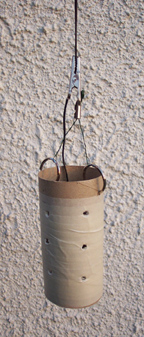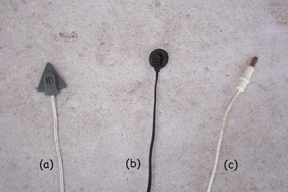
![]() Measuring Temperatures Accurately
Measuring Temperatures Accurately
By Sue Brooks
Getting the temperatures right for the species of tortoise or turtle you keep is fundamental to its well being, but actually taking temperatures is not always as simple as it at first appears.
In any given situation every type of surface will have its own temperature, whether it be a concrete patio or your own skin because everything absorbs or reflects heat at a different rate. This is most evident when the sun is shining. Simple observation in your garden will show the difference in temperature between an area of damp earth in direct sunlight and an area covered by a metal sheet in direct sunlight. And we are all aware too of the contrast in temperature between a grassy area and a concrete path when we walk out with bare feet on a sunny day. Because of this the only relevant temperature we can take in most circumstances is the air temperature and unfortunately this cannot be done by just sticking a thermometer or probe out in the direct sun. Putting an average thermometer or temperature probe into direct sunlight will produce a distorted meaningless reading as the instrument struggles to cope with the various internal expansions this will cause. More expensive equipment is available which minimises this effect but for the purposes of this article I will assume that most of us would be using the more readily available cheaper types of thermometer.
Let us look at what goes wrong when someone tries to use a glass or plastic thermometer in direct sunlight. The sun hits the glass or plastic and the inside of the thermometer reacts in exactly the same way as the inside of your greenhouse does when the sun shines on it, becoming much hotter than the surrounding air due to the effect of the sun's rays through the glass. Added to this there is the effect of the curved glass or plastic of the thermometer effectively becoming a miniature magnifying lens and you can see how distorted the picture becomes. Even the commonly used sensors and probes such as those illustrated will be subject to distortion when placed out in direct sunlight. Sticking a probe or flexi thermometer to the carapace of your tort will only result in a distorted reading too
As already mentioned the only meaningful temperature is the air temperature, which needs to be taken in some degree of shade, not 'in the shade' as in a very shady place but with the thermometer or probe shaded from direct sunlight and not directly touching another surface. In order to measure temperatures in the sun you can use something like the inner tube of a kitchen paper towel roll to protect the probe or thermometer from the distorting effect of direct sunshine and suspend it at least 3' off the ground. Make some air holes so that the air can pass freely over the probe and try not to take temperatures directly above a hot patio area where the slabs will be radiating extra heat.

Swaying this devise gently will ensure that air passes evenly over the probe. In a recent experiment on a sunny day in my garden I recorded temps between 38ºC and 45ºC when the three probes shown were exposed to direct sunlight. Then using the simple tube device illustrated was able to establish that the actual air temp was around 24ºC. Probe (c) showed the greatest distortion in this experiment.

Distortion also occurs but to a much lesser degree when we put a thermometer or probe under a UV-B light. The way I go about measuring the temperature under my lamps is to use a probe such as those illustrated and cover it with a small handful of shredded paper. I would then give it a minimum of two hours, three if it were the first time I was using a particular set-up, before I decided what the basking temp was likely to be. This is because it takes some time to heat the air in between the lamp and the basking area of the enclosure and what may not be understood by new keepers is that it is really the temp after two hours or so that we are aiming for anyway. If you start your enclosure off with a temp of 28ºC, say at 8am, it is going to be well into the 30's by mid-day (which may be hotter than you would wish), depending on the species of tortoise you keep. We want to replicate a normal pattern of being slightly cooler in the morning then rising to a max about 11am onwards. Probe (a) seemed to show the least distortion in my set ups, presumably because it had its own protective cover.
The ideal way of using a UV-B lamp is in a vertical hanging position at the end of an adjustable chain or cord as there will be times when it might need to be closer and times when it should to be further away to achieve your species' appropriate basking temp. It is important to mention here that there should be cooler areas in all set ups so that tortoises and turtles can regulate their body temps by moving away from the basking areas.
Thermometers and temperature probes are cheap and readily available nowadays but using them correctly needs just a little extra thought at times. Hopefully these guidelines will help to reduce some of the common misunderstandings and help us in setting up our tort habitats with greater accuracy.